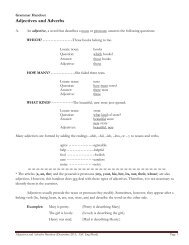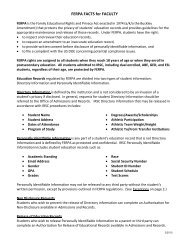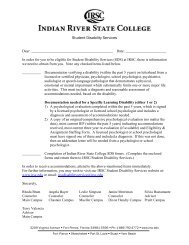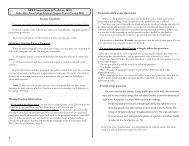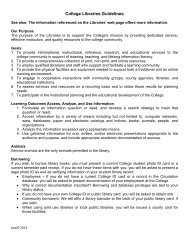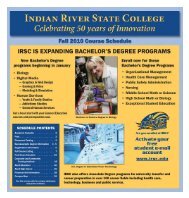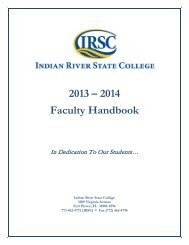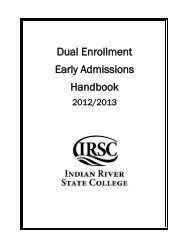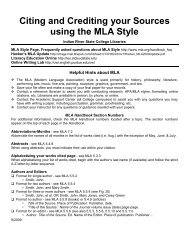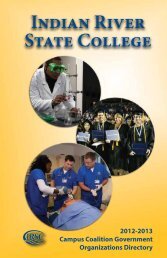MLA Citation Style - Indian River State College
MLA Citation Style - Indian River State College
MLA Citation Style - Indian River State College
Create successful ePaper yourself
Turn your PDF publications into a flip-book with our unique Google optimized e-Paper software.
<strong>MLA</strong> <strong>Citation</strong> <strong>Style</strong> (7 th Edition, 2009)<br />
<strong>Indian</strong> <strong>River</strong> <strong>State</strong> <strong>College</strong> Academic Support Center (Version 2012)<br />
In-text <strong>Citation</strong>s<br />
In the written body of your paper, you must give credit whenever you quote or use<br />
another’s words, ideas, or thoughts. You give credit by using in-text citations that<br />
typically consist of the author’s last name (or the title of the source if the author is<br />
unknown) and a reference marker (e.g., page number). Place a citation as close to the<br />
quoted or paraphrased material as possible without disrupting the sentence.<br />
Subsequent <strong>Citation</strong>s Within a Paragraph – <strong>MLA</strong> 6.3<br />
If you borrow more than once from the same source within a single paragraph and<br />
no borrowing from another source intervenes, you may give a single parenthetical<br />
reference after the last borrowing.<br />
Missing <strong>Citation</strong> Information<br />
*If no author is given, use an abbreviated version of the title (see examples).<br />
*When a source lacks page numbers or any other kind of reference number, cite<br />
the author without a page reference. If a source has numbered paragraphs or sections,<br />
use the abbreviation "par." or “sec.” followed by the number (Hall, par. 5).<br />
General Guidelines for Quotations<br />
If a quotation is less than four typed lines in length, incorporate it into the text of<br />
your report. Do not use a quotation as a complete sentence all by itself.<br />
Note: When you use quotations, you must use the author’s exact words (and<br />
interior punctuation and spelling). Note some exceptions in the examples that follow.<br />
Examples<br />
Circadian rhythms are “[biological] processes that occur repeatedly on<br />
approximately a twenty-four hour cycle” (Feldman 125).<br />
Note: Brackets are used to enclose a word for clarification that was not in the<br />
original quote. Since the quotation is blended into the sentence, a comma before the<br />
quotation and a capital letter on the first word in the quotation are not required.<br />
Czeisler writes, “The timing of the light . . . had to be sinchronized [sic] with<br />
particular phases of a person’s circadian rhythm in order for it to be effective.”<br />
Note: Ellipsis points are used to show that some of the author’s words have been<br />
omitted, and brackets enclosing “sic” are used to indicate that the word “synchronized”<br />
was misspelled in the source.<br />
Long Quotations (more than four typed lines) – <strong>MLA</strong> 3.7.2<br />
*Use a colon to introduce the quotation.<br />
*Starting a new line, indent the entire quotation one inch from the left margin.<br />
*Use the normal right margin and double space.<br />
*Do not put quotation marks around an indented quotation.<br />
*Place the citation in parentheses at the end of the quotation.<br />
Example (long quotation)<br />
Other studies have revealed similar results. For example, researcher Czeisler explains<br />
his findings:<br />
People exposed to five hours of bright lights during the nighttime over a threeday<br />
period reset their internal clocks as much as twelve hours. The timing of the<br />
light could not be haphazard, however. The exposure had to be synchronized<br />
with particular phases of a person's circadian rhythm in order for it to be<br />
effective. (72)<br />
In-text <strong>Citation</strong> Examples<br />
In-text citations are written either as a signal phrase or parenthetical reference:<br />
The reference marker for the cited material is placed in parentheses at the end of the<br />
sentence containing the quotation, paraphrase, or summary, followed by a period after<br />
the parentheses.<br />
Signal phrase in a quotation<br />
Czeisler reports, "Bright light produces a clear resetting of the subject's circadian<br />
rhythms, yet it is too early to know why this happens" (137).<br />
Signal phrase in a paraphrase or partial quote<br />
Czeisler reports that bright light affects one's "circadian rhythms" although the<br />
explanation is not yet known (137).<br />
Signal phrase in a summary<br />
Czeisler finds that the proper timing of bright lights causes a longer period of<br />
alertness and clearer thoughts (137).<br />
Parenthetical reference in a summary.<br />
Other researchers confirm that bright light produces an actual resetting of the<br />
circadian rhythms (Rosenthal 147).<br />
Parenthetical reference in a quotation<br />
Circadian rhythms are “[biological] processes that occur repeatedly on approximately<br />
a twenty-four hour cycle” (Feldman 125).<br />
1
A Work with One Author– <strong>MLA</strong> 6.2-6.3<br />
Signal phrase<br />
In fact, Mapes believes that the accident at the Three Mile Island nuclear power<br />
plant happened because engineers ignored a series of warning signals (15).<br />
Parenthetical reference<br />
The accident at the Three Mile Island nuclear power plant happened at 4:00 a.m.,<br />
and the Chernobyl reactor exploded at 1:23 a.m. (Mapes 15).<br />
A Work with Two or Three Authors – <strong>MLA</strong> 6.2-6.3<br />
List all authors in the signal phrase or parentheses each time you cite the source.<br />
Signal phrase<br />
Worchel and Shebilske report that a person's biological clock is internally set at<br />
twenty-four hours (125).<br />
Parenthetical reference<br />
A person's biological clock is internally set at twenty-four hours (Worchel and<br />
Shebilske 125).<br />
A Work with Four or More Authors – <strong>MLA</strong> 6.2<br />
When the work has more than three authors, follow the form you use in the Works<br />
Cited section of your paper; i.e., either list the first author's name followed by et al.<br />
(Latin for “and others”) or give all the last names.<br />
Signal phrase<br />
Czeisler et al. find similar results in monkeys (155).<br />
Parenthetical reference<br />
Similar results have been found in monkeys (Czeisler et al. 155).<br />
Similar results have been found in monkeys (Czeisler, Johnson, Duffy, Brown,<br />
Ronda, and Kronauer 155).<br />
Unknown Author – <strong>MLA</strong> 6.4.4<br />
If the author is not given, either use the complete title in the signal phrase or use the<br />
full title (if brief) or a shortened form of the title in parentheses.<br />
Complete title in the signal phrase<br />
The article "Are You a Day or Night Person?" states that the pineal gland, which<br />
releases melatonin at night, regulates the biological clock (14).<br />
Partial title in the parenthetical reference<br />
The pineal gland, which regulates melatonin at night, regulates the biological clock<br />
("Are You" 14).<br />
Corporate Author – <strong>MLA</strong> 6.4.5<br />
For names of groups that serve as authors, use the name of the corporate author in<br />
the signal phrase or the parenthetical reference. If you give the name in the<br />
parenthetical reference, you may abbreviate it.<br />
Signal phrase<br />
The National Institute of Mental Health is studying the effect that altering circadian<br />
rhythms has on the memory (91).<br />
Parenthetical reference<br />
Scientists are studying the effects that changing circadian rhythms may produce on<br />
the memory (Natl. Inst. of Mental Health 91).<br />
A Work in an Anthology or Collection Edited by Another– <strong>MLA</strong> 6.2<br />
If you are citing an essay that appears within a collection or anthology, cite the author<br />
of the essay or article – not the editor.<br />
The black box in “The Lottery” symbolizes the towns people’s fear as evident in the<br />
words “the villagers kept their distance” and “there was hesitation” before two men<br />
volunteered to help steady the box (Jackson 572).<br />
Note: On the Works Cited page, you will cite the author and the title of the essay<br />
followed by the editor, title, and publishing information for the anthology or collection.<br />
(5.5.6)<br />
A Scholarly Article Reprinted in a Collection – <strong>MLA</strong> 6.2<br />
If you are quoting or paraphrasing a work that was previously published, cite the<br />
author of the work, not the collection’s author or editor.<br />
Demont reports that most individuals feel sleepy in mid-afternoon, a phenomenon<br />
due solely to the time of day, not to eating a heavy lunch (103).<br />
Note: On the Works Cited page, you will indicate that you were reading an article<br />
reprinted in Feldman’s book and were not reading the originally published Demont<br />
article. You will cite the original publishing information of Demont (usually found at the<br />
end of the article). Then you will add Rpt. in followed by the title, editor, publishing<br />
information, and page numbers of the book in which the article appears. If you are<br />
citing an excerpt of Demont’s work that you found in Feldman’s book, you will add<br />
Excerpt from instead of Rpt. in. (5.5.6)<br />
2
Indirect Sources – <strong>MLA</strong> 6.4.7<br />
When quoting or paraphrasing a quotation from an indirect source (a source quoted<br />
in the source you used), put the abbreviation qtd. in (“quoted in”) before the indirect<br />
source cited in your parenthetical reference.<br />
A reprinted quotation with a signal phrase<br />
Demont states that “feeling sleepy in mid-afternoon is a phenomenon due solely<br />
to the time of day, not to eating a heavy lunch” (qtd. in Feldman 65).<br />
Note: In this situation, Demont’s entire article is not found in the book by<br />
Feldman; Feldman has only quoted from Demont’s article. In the Works Cited page, you<br />
will include a cite for Feldman (and not for Demont) because the quote was obtained<br />
indirectly from Feldman’s book.<br />
Literature – <strong>MLA</strong> 6.4.8<br />
For verse plays and poems, cite the canto, stanza, and line number. For plays, give<br />
the act, scene, and line numbers (if used). Use periods between these numbers. If only<br />
line numbers are cited, the first cite should include the word line; subsequent cites will<br />
be only the number.<br />
For novels, if you give the chapter and the page number, your citation will be easier<br />
to find in any edition of the novel. If you use both a page number and chapter number,<br />
follow the page number with a semicolon and precede the chapter number with the<br />
abbreviation ch.<br />
A poem with a signal phrase<br />
In “The Bustle in a House,” Emily Dickinson describes the emotional<br />
housecleaning after death by the words “The Sweeping up the Heart / And putting<br />
Love away” (lines 5-6).<br />
A verse play with a parenthetical reference<br />
“The lady doth protest too much, methinks” is a frequently quoted line from Hamlet<br />
(Shakespeare 3.2.206).<br />
A novel with a signal phrase<br />
Conrad is quite adept at using animal imagery as when Gentleman Brown identifies<br />
himself as “a rat in a trap” (232; ch. 41).<br />
Works Cited Format: Printed Resources<br />
Note: Abbreviate publishers’ names.<br />
Book with One Author – <strong>MLA</strong> 5.5.2<br />
Hartman, Charles. The Sleep Book. Chicago: Foresman, 1987. Print.<br />
Book with Two or Three Authors – <strong>MLA</strong> 5.5.4<br />
Worchel, Stanley, and William Shebilske. Psychology: Principles and Application. Newark:<br />
Prentice, 1996. Print.<br />
Book with Four or More Authors – <strong>MLA</strong> 5.5.4<br />
Gillman, Sandra, et al. Hysteria Beyond Freud. Berkeley: U of California P, 1993. Print.<br />
Unknown Author of an Article in a Weekly Magazine – <strong>MLA</strong> 5.4.6 and 5.4.9<br />
If the page numbers are not consecutive, cite only the first page number and a plus<br />
sign.<br />
"Are You a Day or a Night Person?" Newsweek 7 Mar. 1994: 26+. Print.<br />
Corporate Author – <strong>MLA</strong> 5.5.5<br />
Cite the author by the corporate author (American Medical Association, Public<br />
Health Foundation) even if the corporate author is the publisher. Omit any article (A,<br />
An, The) in the beginning of the name.<br />
Public Health Foundation. The Timing is Wrong. Boston: Public Health Foundation, 1992.<br />
Print.<br />
Work/Essay in an Anthology or Collection Edited by Another – <strong>MLA</strong> 5.5.6<br />
Cite the author and title of the work; then cite information for a basic book entry. The<br />
edition follows the name of the editor if there is one (if not, after the name of the<br />
book). Place the title of the work in quotation marks unless it was originally published<br />
independently (such as novels and plays). Italicize the title of independently published<br />
works.<br />
Shakespeare, William. Hamlet: Prince of Denmark. Literature: Reading Fiction, Poetry, and<br />
Drama. Ed. Robert DiYanni. 6 th ed. Boston: McGraw, 2008. 1545-1648. Print.<br />
Dickinson, Emily. “The Bustle in a House.” Literature: Reading Fiction, Poetry, and Drama.<br />
Ed. Robert DiYanni. 6 th ed. Boston: McGraw, 2008. 936. Print.<br />
3
A Scholarly Article Reprinted in a Collection – <strong>MLA</strong> 5.5.6<br />
Cite the author, title of the work, and earlier publication information. Then add Rpt.<br />
in (“Reprinted in”) followed by information for page numbers and print medium of the<br />
collection in which the article appears. The print medium for the earlier publication is<br />
not required.<br />
Demont, Alex. "Like Clockwork." The Science Monitor 9 Aug. 1993: 127. Rpt. in Essentials<br />
of Understanding in Psychology. 2nd ed. Ed. Robert Feldman. New York: McGraw,<br />
1994. 102-104. Print.<br />
Article in a Journal – <strong>MLA</strong> 5.4.2<br />
Newman, Timothy. "Can We Regulate Circadian Rhythms?" Journal of Natural Healing<br />
6.2 (1994): 72-78. Print.<br />
Aslan, Joseph. "Group Treatment of Sleep Disorders." Journal of Health 22 (1993): 221-<br />
26. Print.<br />
Works Cited Page: Electronic Resources<br />
Article, Scholarly Journal (Online database) - Full Text – <strong>MLA</strong> 5.6.4<br />
Clemmitt, Marcia. “Cyber Socializing.” CQ Researcher 16.27 (2008): 625-648. CQ<br />
Researcher Plus Archive. Web. 3 Aug. 2008.<br />
Article, Scholarly Journal (Web) – Full Text – <strong>MLA</strong> 5.6<br />
Howe, Jeff. “Social Networking Hits Campus.” Journal of Students 3.2 (2009): 32-43. Web.<br />
13 May 2009.<br />
Article, Magazine (monthly) (Online database) – Full Text – <strong>MLA</strong> 5.6.4<br />
Lane, Mandy. “Cyberscope.” Ms Magazine Aug. 2008: 16. Business Source Complete. Web.<br />
21 June 2008.<br />
Article, Magazine (weekly) (Online database) – Full Text – <strong>MLA</strong> 5.6.4<br />
Corey, Patti. “H1N1 Scare.” Time 4 Aug. 2009: 59. Business Source Premier. Web. 23 Aug.<br />
2009.<br />
Article, Online Magazine (monthly) (Web) – Full Text – <strong>MLA</strong> 5.6<br />
Howe, Jeff. “H1N1 Hits Campus.” Campus Health Issues. Campus Health, Aug. 2009.<br />
Web. 3 Sept. 2009.<br />
Article, Online Magazine (weekly) (Web) – Full Text – <strong>MLA</strong> 5.6.2b<br />
Letterman, David. “CBS Librarian Researches Top Ten Lists.” TelevisionToday.com.<br />
Television Today, 4 Aug. 2009. Web. 3 Sept. 2009.<br />
Article, Newspaper (Online database) – Full Text – <strong>MLA</strong> 5.6.4<br />
Craig, Kevin. “Differing Views of One Truth.” Globe & Mail 8 Jan. 2003: 20. Opposing<br />
Viewpoints Resource Center. Web. 17 Mar. 2008.<br />
Article, Newspaper (Web) – Full Text - <strong>MLA</strong> 5.6<br />
Lomartire, Paul. “Spielberg‟s Earth 2.” Palm Beach Post. The Palm Beach Post, 5 Nov.<br />
1994: C2. Web. 3 May 2009.<br />
Blog – <strong>MLA</strong> 5.6.2b<br />
If there is no title for the blog entry, label it Weblog comment, but do not add<br />
quotation marks. If there is no sponsor or blog publisher, type N.p.<br />
Kendrick, Marta. “Future of Novels.” Free Range Librarian. Wordpress, 23 June 2009.<br />
Web. 31 Jul. 2009.<br />
Book (eBook from the Web) – <strong>MLA</strong> 5.6<br />
Carroll, Lewis. Hunting of the Snark. NY: Macmillan, 1891. University of Virginia Library.<br />
Web. 21 Oct. 1995.<br />
Dictionary Entry – <strong>MLA</strong> 5.6.2 and 5.5.7<br />
Oftentimes, the dictionary will provide several definitions for the same word and<br />
number them (Def. #).<br />
“Literature.” Def. 3a. Merriam-Webster Online Dictionary. Merriam-Webster Online, 2008.<br />
Web. 19 Aug. 2011.<br />
Discussion Groups, eConferences, Bulletin Boards, etc. (Web) – <strong>MLA</strong> 5.6.2b<br />
Magnuson, Nancy. “Digitizing Books.” Online posting. 15 June 1995. <strong>College</strong> Libraries<br />
Bulletin Board. Web. 21 Oct. 1995.<br />
Encyclopedia Article – <strong>MLA</strong> 5.5.7 and 5.6.2<br />
“Henri Bergson.” Britannica. Encyclopaedia Britannica, 2008. Web. 15 Aug. 2011.<br />
4
Government Documents (Web) – <strong>MLA</strong> 5.5.20 and 5.6<br />
United <strong>State</strong>s. Dept. of Justice. Crime Rates Increase during Winter Months. By John<br />
Timmons, Mary Jones, and Tom Bluestone. Feb. 2002. Web. 21 Oct. 2002.<br />
Homepage (Web) – <strong>MLA</strong> 5.6.2b<br />
Shelley, Mary. Victor Frankenstein: An Absent Parent. Mary Shelley. n.d. Web. 22 June<br />
1998.<br />
Note: When a professional or personal site has no title, use the description “Home<br />
page” without italics and without quotations. You may want to include the Web address<br />
for this type of citation. For example:<br />
Chambers, Allison. Home page. Allison Chambers. 7 June 2003. Web. 8 July 2005.<br />
.<br />
Poem (Online database) - <strong>MLA</strong> 5.6.4<br />
Browning, Robert. “Half-Rome.” Columbia Granger's World of Poetry Online. Web. 18 Aug.<br />
2009.<br />
Works Cited Page: Missing <strong>Citation</strong> Information<br />
Use the following abbreviations for information that cannot be supplied.<br />
n.p. No place of publication or no publisher.<br />
n.d. No date of publication given.<br />
n. pag. No pagination given.<br />
Photographs of the Big Bend, Fort Davis, the Rio Grande, and West Texas Historical Sites. N.p.,<br />
n.d. N. pag. Print.<br />
For a more detailed guide to <strong>MLA</strong> style, visit the one of the following IRSC<br />
library or ASC websites:<br />
http://www.irsc.edu/libraries/tutorials/tutorials.aspx?id=1239<br />
General <strong>MLA</strong> Guidelines<br />
Use 8 ½ x 11 inch white, standard typing paper.<br />
Double space the entire paper and use a standard black typeface (not script or italics).<br />
Except for page numbers, leave margins of one inch on all sides of paper. Let the right<br />
margin remain uneven. Do not justify.<br />
Create a header in the upper right-hand corner that includes your last name, followed by<br />
a space and a page number. Number all pages consecutively with Arabic numbers, onehalf<br />
inch from the top and flush with the right margin.<br />
Center your title on the first page of the paper, and double space between it and the<br />
header. If your instructor prefers a separate title page, see page 6 for a sample title page.<br />
Do not underline your title, place it in quotation marks, or put it in all capital letters.<br />
(Italicize or place in quotation marks only those words that would normally be italicized<br />
or in quotation marks, e.g., the name of a book that you have included in your title.)<br />
Space once after the following punctuation marks:<br />
*After commas, colons, and semicolons.<br />
*After concluding punctuation (unless your instructor prefers two spaces).<br />
*After periods within author, date, title, or publishing information of a citation on<br />
the Works Cited page.<br />
*After periods following initials in personal names (J. R. Harris).<br />
When writing about literature or general truths, use the present tense<br />
Always check with instructor for exact requirements.<br />
http://www.irsc.edu/students/academicsupportcenter/researchpaper<br />
/researchpaper.aspx?id=4294967444<br />
5
Sample <strong>MLA</strong> First Page and Works Cited Page<br />
Andrews 1<br />
Pat Andrews<br />
Professor Manning<br />
Introduction to Research 1201, Section A1<br />
17 November 2012<br />
Texting While Driving: A Deadly Dilemma<br />
When Gary Golatas climbed into the passenger seat of Allyson<br />
P. Smitter’s sports car on the morning of July 4, 2011, he had no<br />
idea that she would be taking him for his last ride. According to an<br />
article in the Terlingua Daily Express, Golatas, 17, and Smitter, 18,<br />
had planned a holiday excursion to festivities in nearby Appaloosa<br />
County. Six months later, it was no holiday when a Kiva County<br />
grand jury indicted Smitter for vehicular homicide (Buck A1+).<br />
Texting, statistics prove, is not only rising but creating<br />
problems on the nation’s highways. In the United <strong>State</strong>s, texting<br />
increased from 9.8 billion messages a month in January of 2009 to<br />
99.4 billion in January of 2010 (Bandelier 28). As quoted in “Time<br />
for a Change,” researcher Alan M. Tercero claims, “As many as 70<br />
percent of those messages are being sent by people driving cars”<br />
(Automotive Review Council 29). An insurance accident<br />
investigator, Barry Hulicki, says that drivers using cell phones<br />
Andrews 6<br />
Works Cited<br />
"Are You a Day or Night Person?" McCalls Mar. 1994: 12. Print.<br />
Automotive Review Council. Time for a Change. Stuart: Automotive Review<br />
Council, 2009. Print.<br />
Bandelier, Adolfo. “Watching Out for You.” Scholarly Journal of Automotive<br />
Safety and Security 22 (2007): 26-30. Web. 11 Feb. 2012.<br />
Buck, Arva. “Texting Driver Involved in Fatal Accident.” Terlingua Daily<br />
Express 10 July 2011: A1+. Print.<br />
Demont, Alex. "Like Clockwork." The Science Monitor 9 Aug. 1993:127. Rpt.<br />
in Robert Feldman. Essentials of Understanding in Psychology. 2nd ed. New<br />
York: McGraw, 1994. 102-104. Print.<br />
Howe, Jeff. “Social Networking Hits Campus.” Journal of Students 3.2<br />
(2009): 32-43. Web. 13 May 2009.<br />
Lane, Mandy. “Cyberscope.” Ms Magazine Aug. 2008: 16. Business Source<br />
Complete. Web. 21 June 2008.<br />
Rosenthal, Edgar. "Pulses of Light Give Astronauts New Rhythms." New<br />
York Times 23 Apr. 1991, sec. 1: 1. Print.<br />
Shelley, Mary. Victor Frankenstein: An Absent Parent. Mary Shelley. n.d. Web.<br />
22 June 1998.<br />
6



